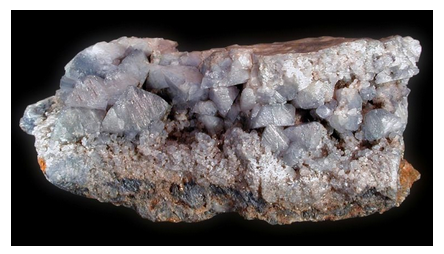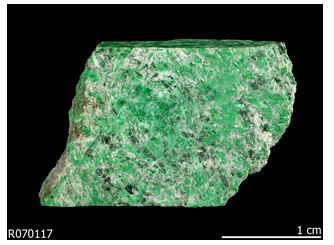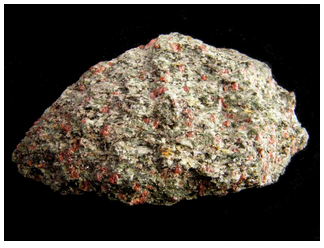8.8: High-Pressure Rocks and Minerals
- Page ID
- 18630
| Common Minerals in Metamorphosed High-Pressure Rocks |
|||
| minerals | |||
| low gradeem>high grade |
glaucophane lawsonite epidote jadeite aragonite kyanite garnet (pyrope-almandine) omphacite |
||
Because of their tectonic significance, petrologists group high-pressure metamorphic rocks into a class unrelated to rock composition. These rocks include mainly blueschists and eclogites, both quite rare. They come from deep in Earth, and special conditions are required to create them and bring them to Earth’s surface. Blueschist is a name given to one type of rock that forms at conditions within the blueschist facies, a facies characterized by high pressure and relatively low temperature. Blueschist chemistry is variable. Compositions range from pelitic to mafic. No matter their compositions, they contain conspicuous mineralogy.
A blue amphibole, called glaucophane, is responsible for the name of the facies. The blueschist seen below in Figure 8.78 is mostly glaucophane. Other common blueschist minerals include a colorless to green Na-pyroxene called jadeite, green or white lawsonite, and pale aragonite (the high-pressure polymorph of calcite). Epidote, garnet, zoisite, quartz, and other accessory minerals may also be present. Because they form at low temperature, blueschists are often fine grained, poorly crystallized, and difficult to study.
Eclogites, such as the one seen below in Figure 8.79, are mafic rocks metamorphosed at high pressure and moderate-to-high temperature. They contain the essential minerals pyrope (Mg-rich garnet) and the green Na-rich clinopyroxene called omphacite. Orthopyroxene may also be present in significant quantities. Accessory minerals include kyanite, quartz, spinel, titanite, and many others. Eclogites originate in the deep crust or in the mantle. Many mantle xenoliths, carried up as nodules within magma, are eclogites. Eclogites are also found as layers or bands associated with some peridotites. Quite commonly, eclogites undergo retrograde metamorphism and so become partially changed into blueschists.
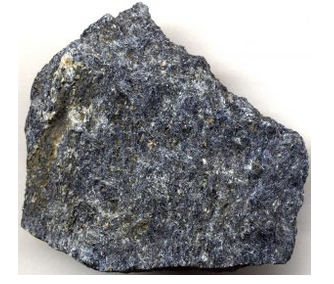
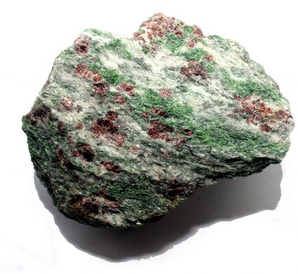
The photos below show some additional examples of high-pressure minerals. The light-colored crystals in Figure 8.80 are lawsonite. Lawsonite has about the same composition as anorthite. But plagioclase (including anorthite and albite components) becomes unstable at high pressure, so the anorthite part hydrates and we get lawsonite instead. The green jadeite, in Figure 8.81, is an Na-rich pyroxene that is only stable at high pressure. It forms because the albite component in plagioclase changes by solid-solid reaction into Na-pyroxene. Glaucophane, the inky blue mineral in the lower left photo (Figure 8.82) is an Na-rich amphibole. Like omphacite, it incorporates its sodium component from albite. In this specimen, a silvery and greenish chrome mica, fuchsite, accompanies the glaucophane. The green omphacite in the lower right photo (Figure 8.83) is a pyroxene that includes a few high-pressure components. And the pyrope (red garnet) in the same sample formed by solid-solid reactions involving pyroxenes.
